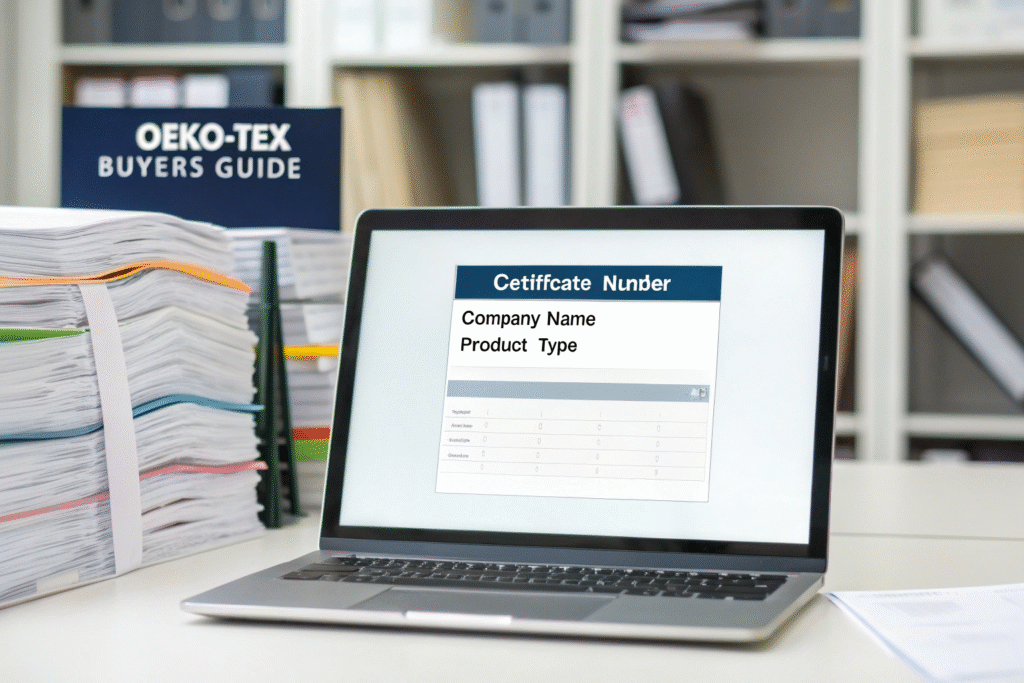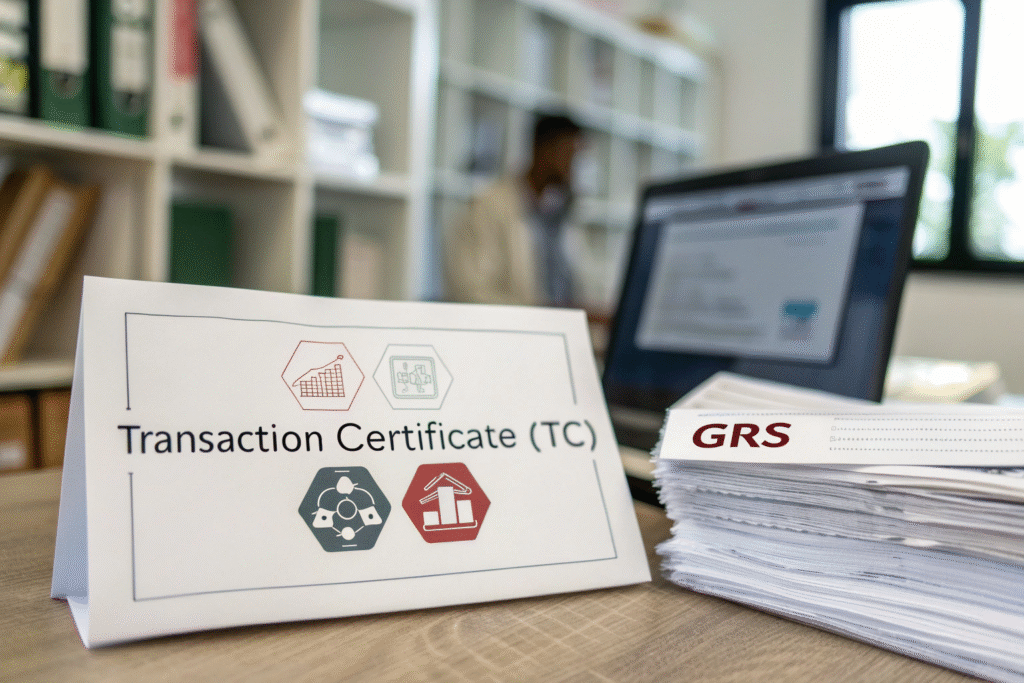As a fabric supplier with over two decades in the industry, I've seen a surge in demand for certified sustainable and safe textiles. Buyers like you are rightfully cautious. You need to trust, not just hope, that the GRS (Global Recycled Standard) and OEKO-TEX® certificates presented by suppliers are genuine and valid. An invalid certificate can lead to rejected shipments, financial loss, and severe damage to your brand's reputation. So, how can you, as a buyer, move from simply receiving a certificate to confidently verifying its authenticity? This guide will walk you through the exact steps.
Verifying GRS and OEKO-TEX® certificates is a critical due diligence process that protects your business from fraud and ensures your products meet the ethical and safety standards you promise your customers. It involves checking the certificate's unique ID, supplier details, and scope against the official, public databases maintained by the certification bodies.
Don't let a complex supply chain obscure the truth about your materials. Taking a few minutes to verify certifications can save you from costly mistakes and solidify your partnerships with trustworthy suppliers. Let's dive into the practical steps you need to take right now.
How can I check if a GRS certificate is real?
A genuine GRS certificate is your assurance that the recycled content in your fabric is tracked and verified from source to final product. Faking a PDF is easy; faking an entry in an official database is not. The verification process is your first line of defense against greenwashing.
The most reliable method is to use the official Textile Exchange database. Textile Exchange is the organization that owns and manages the Global Recycled Standard. They host a public-facing platform where you can search for all certified entities. When a supplier sends you a GRS certificate, you must go directly to this database and cross-check the information. Do not rely on the PDF alone.

What specific details should I match on a GCS certificate?
When you access the official Textile Exchange Claims Guide, you'll understand the importance of the claims process. On the certificate and in the database, you need to verify several key pieces of information. First, check the certificate number. This unique ID is the primary key. Second, verify the company name and address exactly as they appear on the document. A slight mismatch could indicate a fake or an expired certificate for a different entity. Third, confirm the scope of certification. This details which specific processes and products are certified. For instance, is only the spinning mill certified, or is the weaving and dyeing factory included? Finally, always check the issue and expiry dates. A certificate is only valid for a specific period, usually one year.
What are the red flags for a fake GRS certificate?
Even with a database, you need a critical eye. Several warning signs should prompt immediate follow-up with your supplier. A blurry or low-resolution logo is a common first clue. An inability to provide a full, multi-page certificate is another; genuine certificates are detailed documents. If the supplier hesitates or gives excuses when you ask for the certificate number to verify online, consider it a major red flag. Furthermore, if the scope of the certificate does not cover the specific processes your fabric undergoes—for instance, if the certificate is for a trading company but claims to cover the weaving and dyeing done at another facility—the claim may not be valid for your order. Always ensure the entire chain of custody is certified.
What is the correct way to verify an OEKO-TEX® STANDARD 100 label?
OEKO-TEX® certification focuses on human-ecological safety, testing for harmful substances. Verifying an OEKO-TEX® STANDARD 100 certificate follows a similar principle but uses a different official tool. The integrity of your brand depends on the safety of your materials, making this verification non-negotiable.
The only authoritative source for verification is the OEKO-TEX® Buyers Guide. This is a dedicated online database where you can search by certificate number, company name, or product type. It is updated regularly and provides the definitive status of any OEKO-TEX® claim. Simply entering the certificate number from your supplier's document into this portal will tell you if it is active and valid.

How do I use the OEKO-TEX® certificate number checker?
The process is straightforward. When you receive an OEKO-TEX® STANDARD 100 certificate, locate the unique certificate number. It typically looks something like "12345.HKT.500". Go to the official OEKO-TEX® Certificate Checker webpage. Enter this number into the search field. The system will then display the current status of the certificate, the company it belongs to, the certified product article, and its validity dates. If the number returns no results or shows a "suspended" or "withdrawn" status, the certificate is not valid, and you should not accept the goods under that claim.
What does the product class on an OEKO-TEX® certificate mean?
A crucial part of verification is confirming the correct product class. OEKO-TEX® classifies products into four classes based on human ecological safety requirements, with Class I being the strictest for baby products. Here is a simple breakdown:
| Product Class | Description | Intended Use |
|---|---|---|
| Class I | Highest safety requirements | Articles for babies and toddlers |
| Class II | High safety requirements | Articles with direct skin contact (e.g., blouses, shirts) |
| Class III | Medium safety requirements | Articles with no or little skin contact (e.g., jackets, coats) |
| Class IV | Basic safety requirements | Decoration and furnishing materials (e.g., tablecloths, curtains) |
You must ensure that the product class on the certificate matches your product's intended use. Using a Class IV certified fabric for a baby's onesie would be a serious compliance failure and a safety risk. The official database will clearly state the product class for the certified article.
Why is supply chain transparency crucial for certification?
A certificate for a single company is not enough. For a claim like GRS to be valid for a final garment, every step of the supply chain must be certified. This is called Chain of Custody (CoC). Without it, you cannot reliably claim the recycled content.
The final product's certification is only as strong as its weakest link. If you buy fabric from us, and we are GRS-certified, but our yarn supplier is not, the entire chain is broken. A reputable supplier will have a transparent and certified supply chain and will be able to provide you with the Transaction Certificates (TCs) that prove the certified material flowed through each step.

What is a Transaction Certificate (TC) and why do I need it?
A Transaction Certificate (TC) is a document that provides physical evidence of the transfer of certified materials from one certified entity to another in the supply chain. It is the legal proof that the recycled or safe-treated material was actually used in your specific order. When you purchase GRS-certified fabric, you should request a TC from your supplier. This TC will trace the material back to the previous certified source, creating an unbroken chain. For OEKO-TEX®, while TCs are less common for the STANDARD 100 label, the supply chain transparency for the MADE IN GREEN label is critical, which tracks the product through certified production facilities.
How can I assess my supplier's overall transparency?
Asking the right questions is key. Go beyond just asking for a certificate. Ask your supplier: "Can you provide Transaction Certificates for my orders?" or "Can you map your entire supply chain for this product and show me the certifications for each facility?" Their willingness and ability to answer these questions clearly and quickly is a strong indicator of their transparency and reliability. At our company, we maintain detailed records and certified partnerships for all our eco-friendly product lines, ensuring a seamless and verifiable chain for our clients.
How can my supplier help simplify the verification process?
A trustworthy supplier doesn't just provide certificates; they make verification easy, transparent, and integrated into your workflow. They act as a partner in your compliance journey, not an obstacle.
The best suppliers build certification and transparency into their core operations. They use digital tools to provide instant access to certificate libraries, offer QR codes on invoices that link directly to the official database, and have dedicated quality control teams that manage this information. For example, in our CNAS-accredited lab, we can provide detailed test reports that complement the certification, giving you multiple layers of validation.

What digital tools should I look for in a supplier?
Modern supply chains are digital. Look for suppliers who offer a secure client portal on their website where you can download all relevant certificates and TCs for your orders. Some progressive companies are even integrating blockchain technology for immutable tracking. Another simple tool is the use of QR codes. A QR code printed on a physical tag or an invoice that links directly to the live database entry for that certificate is a sign of a confident and transparent partner. This eliminates the need for emailing PDFs and ensures you are always looking at the most current data.
What questions should I ask a potential supplier about certifications?
Your initial sourcing discussions must include certification due diligence. Here are essential questions to ask:
- "Are you certified for the specific standard (GRS/OEKO-TEX®) for this product?"
- "What is your certificate number, and can I see it in the official database?"
- "Can you provide Transaction Certificates for every order?"
- "What is the scope of your certification? Does it cover the dyeing/finishing processes?"
- "How do you manage and verify the certifications of your own suppliers?"
Their answers will immediately separate credible partners from the rest.
Conclusion
Verifying GRS and OEKO-TEX® certificates is not a matter of trust but of rigorous process. It protects your investment, your brand, and your customers. By using the official databases, checking all details meticulously, understanding the importance of the supply chain, and partnering with transparent suppliers, you can transform certification from a marketing checkbox into a robust business assurance. This diligence ensures that the sustainable and safe claims on your labels are 100% authentic.
If you are looking for a fabric partner that prioritizes verifiable certification and seamless supply chain transparency for your orders, we are here to help. Our team ensures every meter of fabric meets the strictest standards, backed by genuine, auditable documentation. For a reliable partnership in creating your next clothing line, feel free to reach out to our Business Director, Elaine, at elaine@fumaoclothing.com. Let's build something trustworthy together.










